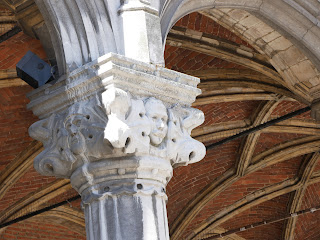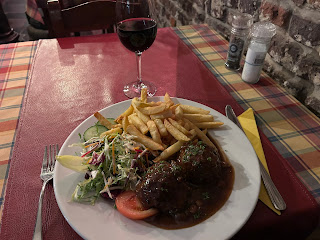One of the other plans I made for my sejour a Liege was a free walking tour. This is something I should have done years ago. I learned a lot about the city I used to call home.
We met at the Palace du Prince-Eveque at Place St.-Lambert, the same place I traveled to daily the three months I lived with my second host family in order to catch the bus to take me back to their home. I stayed a three minute walk from the start of the walk.
It was great hearing English, even if most of our tour group did not speak English as their first language. The tourist office has paid tours in English a few times a week, and will add tours in Dutch starting in May. The tour in English is run by a few friends who wanted to share their love of the city. Elena, our guide, we learned at the end was born in Cincinnati and moved to Liege when she was about six. As expected, she speaks with a midwestern accent. She is a geography teacher. Our tour included 13 people from the Netherlands, France, India, and Los Angeles. I was the only person alone, the only person taking notes, and one of only a couple of people taking pictures. Elena pieced together parts of the history I learned on other tours.Place St.-Lambert is considered the historical center of Liege. The palace was built next to the original cathedral, the one I saw pieces of in the Archeoforum earlier in the week. In the early 8th century, Bishop Lambert was in charge of a large area, including Maastricht, Aachen, and Liege. He was very vocal about the nobleman from Exton who was cheating on his wife, condemning him. Lambert was murdered for his beliefs in this spot, which turned it into a pilgrimage site when Lambert became a martyr. Notger, the first prince bishop (meaning he was both the secular and religious leader) put Liege on the map by building a cathedral in this space, as well as seven (or eight?) collegial churches, a palace, and the city walls. Liege was called the Athens of the North.
The original palace burned down in the early 12th century. The current one was built in the early 16th century. A market was held in the center courtyard (today it is a parking lot). It is a mix of Roman and Gothic styles. Note the one face on the column: it is the architect.
What was once a private residence is now the offices of the ten provinces and courthouse.
The pillars in St.-Lambert represent the outline of the old cathedral. It looked similar to Notre Dame in Paris. The cathedral was run by the bishop, the collegiate churches are run by priest. The original cathedral was destroyed during the era of the French Revolution when the people fought against one man having the power of both the secular and religious sides of life.
The cathedral was moved into St. Paul's collegiate in the center of Liege.
We walked to a fountain in the heart of Liege. It is the symbol of independence. It stands outside the city hall and is where laws were proclaimed and announced. At one point Charles the Bold took it to Bruges, but it was returned after his death and rebuilt.
The red brick city hall is an example of Mosan architecture. Inside the archway are flowers. Violets. The symbol of Liege. Elena handed us each a piece of violet candy in its honor. During my trip I had violet ice cream because it was unique. The next time I had it was in honor of Liege.
The author George de Simenon was born a few minutes after February 13, but his mother changed his birthdate to the twelfth because it sounded lucky. He sits on a bench next to the old police station (now City Hall) because during his life he sat there gathering stories.
The alcohol served there is very typical for Liege. Shots are served in a variety of colors from juniper berries. Nanesse and Chanchone are marionettes that represent the old miners with red cheeks and kerchief, and blue tops.
The old 1888 fountains are almost finished with their renovations. They sparkle. Soon they will have water you'll be able to use to fill water bottles. In the old days houses didn't have water, so these provided water. At the bottom was a basin for dogs, at the top one for horses and people. Over time it was deemed unsanitary. There are five fountains left in the city center. I found three.
The tram is doing test runs. It is at least 7-10 years behind schedule. In addition to the route in the city center, it was supposed to extend in two directions. Work had been started before a new administration came in and the work was ripped up. Throughout the trip I asked people what they thought of it. The answers ranged from super positive: this is exactly what Liege needs; to very pessimistic: too loud, too disruptive. Time will tell. It is slated to open the end of April. Two years ago there was a huge flood in the area (not in downtown Liege), rising up to the first floor in some homes. Before that it was COVID. Both slowed down progress as workers were pulled to make repairs.
La Batte is the oldest marketplace in Belgium. It takes place every Sunday from 6 am to 2 pm. People travel from all over for it. Takes place in front of the tourist center.
Liege has suffered from economic turmoil when the steel factory closed, which led to addictions and begging. The factory employed thousands of people until the beginning of the 21st century. The coal and iron ore mines also closed. The city is struggling to find a different revenue source. At the moment, the hospital is the largest employer. Shops in this part of town suffered when the tram was under construction and foot traffic could not reach them. New shops are now opening. She said she usually sees someone getting arrested when she give a tour, but did not see anyone today. Belgium's other French speaking cities (Namur and Charleroi) are suffering similar fates. They are turning to increasing tourism with more events and the movie industry.
The locals try to support the independent businesses through social media campaigns.
We passed St. Bartholomew Church and the Curtius Museum, which I had already visited. The Curtius has a school where you can learn how to make artesianal weapons.
In front of the church is a statue called Les Principautaires made by Mary Adrien (1992) from the closed steel factory. It shows the tall bishops at the top, and the lowly townspeople below it. It represents the battle against the prince bishops.
The statue in the square is made from stones from the old cathedral.In the 1980s this square was rehabilitated and opened up to the public. They blended the old with the new.
Time to learn about the political history of Belgium. In 1830 they became independent from the Netherlands. At the time they wanted to make French the only language as it was considered the international language of the day. Besides (as I learned on this trip) Flanders is actually a bunch of different dialects. The constitution, courts, and administrative offices would all be in French. The people, though, mostly spoke Flemish. Resentment grew.
Before WWI, the country was bilingual and lived in relative peace. During the war the Flemish-speaking soldiers had French speaking officers who gave order in French. They resented how their language was dismissed. After the war a linguistic border was created, the line shifted every decade as the border was redrawn. Brussels remained bilingual. As does Leuven.
In the 1960s/1970s the final border was put into place and remains.
Today Flanders is stronger financially than the French part. The Flemish have been asking for cultural and lingual independence for years. The French wanted financial independence. Most of the open factories are in the Flemish section.
Today there are seven different governments within the tiny country: Community (Flemish, French, and German); regional (Walloon, French, and Brussels); federal (everyone). Belgians have the highest taxes in the world.
Last October there was an election. It is still not settled. The socialists in the north are different from the socialists in the south. They can't agree on a leader and are at a standstill.
We walked along rue Hors Chateau (outside the castle), this long and wide street is the oldest in Liege. It has shops, churches, and historic building marked by special placards. It used to be a working class neighborhood that has since become gentrified.
Come back the first weekend in October to see the area covered in candles.
We walked to the Montagne de Bueren. Until that moment, I had not appreciated how the streets connected. Suddenly Liege felt smaller than I thought. The stairs were built in 1884 as an access for the army to go from the top (where they were encamped) to the city without passing through the red light district. Today it is the center of many activities, including the beer lovers marathon with beer stops at the top of the stairs and extreme biking.

The tour lasted over 2 hours.
I went to the grocery store to stock up on chocolate. Then I went to the stairs to climb them one last time -- eight minutes up, six down. I am ready for the race.






















No comments:
Post a Comment